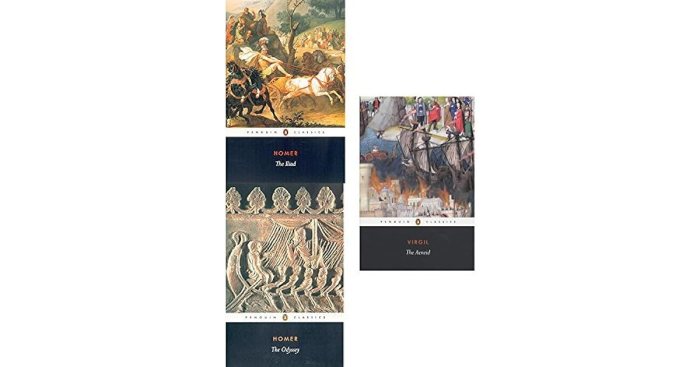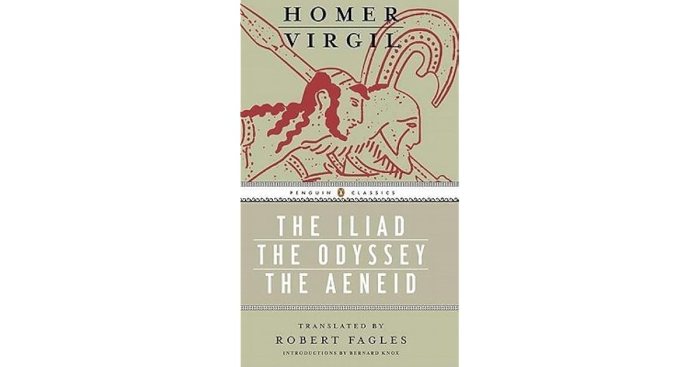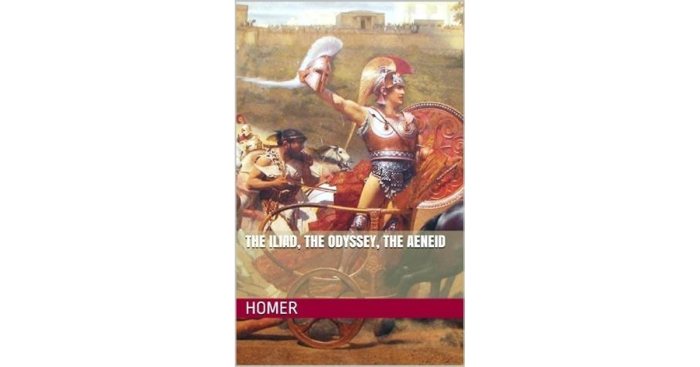The iliad odyssey and aeneid – The Iliad, Odyssey, and Aeneid, monumental epics that have shaped Western literature, stand as testaments to the power of storytelling. From the Trojan War’s fiery battlefields to the perilous journeys of Odysseus, these ancient tales continue to captivate and inspire readers.
These epic poems, spanning centuries and cultures, offer a captivating exploration of heroism, fate, and the human condition. Join us as we delve into the world of these literary giants, uncovering their timeless significance and enduring impact.
Historical Context

The Trojan War, a legendary conflict between the Greeks and the Trojans, played a pivotal role in shaping ancient literature. Its significance is evident in the creation of three epic poems: the Iliad, Odyssey, and Aeneid.
Historical events, such as the Mycenaean civilization’s decline and the rise of the Greek city-states, influenced the development of these epics. The Iliad and Odyssey are believed to have been composed during the 8th century BCE, reflecting the values and beliefs of the Greek Bronze Age.
The Aeneid, written by Virgil in the 1st century BCE, provided a Roman perspective on the Trojan War, connecting it to the founding of Rome.
The Iliad
The Iliad, attributed to Homer, focuses on a specific episode during the ten-year siege of Troy. It depicts the wrath of Achilles, a legendary Greek warrior, after his prize is taken from him. The epic delves into themes of honor, pride, and the destructive consequences of anger.
The Odyssey
The Odyssey, also attributed to Homer, narrates the perilous journey of Odysseus, a Greek king, as he returns home after the Trojan War. The epic explores themes of loyalty, perseverance, and the importance of family.
The Aeneid
The Aeneid, written by Virgil, tells the story of Aeneas, a Trojan hero who flees Troy after its fall. The epic recounts his journey to Italy and his role in establishing the Roman Empire. The Aeneid served as a national epic for the Romans, connecting their origins to the legendary Trojan War.
Epic Structure and Form

The epic poems of the Iliad, Odyssey, and Aeneid share a common structure and form, reflecting the conventions of the epic genre. All three epics employ the following elements:
- Invocation:An appeal to a deity or muse for inspiration and guidance.
- Proem:A brief introduction that states the poem’s subject matter and main characters.
- Episodic narrative:A series of interconnected episodes that recount the hero’s journey and adventures.
Homer and Virgil both employ these structural elements, but they differ in their narrative techniques. Homer’s epics are more episodic, with each episode focusing on a particular event or encounter. Virgil’s Aeneid, on the other hand, is more unified, with a clear and overarching plotline.
Homeric Narrative Techniques
- In medias res:Beginning the narrative in the middle of the action, then providing backstory through flashbacks.
- Epic similes:Extended comparisons that draw on everyday life and nature to illustrate heroic actions.
- Repetition:Use of recurring phrases and epithets to emphasize key themes and characters.
Virgilian Narrative Techniques
- Linear narrative:Telling the story in a chronological order, with minimal use of flashbacks.
- Pathetic fallacy:Using natural phenomena to reflect the emotions of the characters.
- Allusion:References to other myths and legends to add depth and complexity to the story.
Characterization and Themes

The characters in the Iliad, Odyssey, and Aeneid are complex and multifaceted, embodying the epic tradition’s focus on human struggles, values, and motivations. These characters drive the narratives and shape the epic themes, revealing universal truths about human nature and the human condition.
Major Characters
The Iliad revolves around the central conflict between Achilles and Agamemnon, highlighting themes of honor, pride, and the devastating consequences of war. Achilles, the legendary warrior, is a complex character torn between his personal honor and the greater good. Agamemnon, the leader of the Greek forces, embodies the hubris that can lead to downfall.
In the Odyssey, Odysseus, the resourceful and cunning hero, faces countless challenges as he journeys home to Ithaca. Odysseus’s resilience and adaptability reflect the epic’s themes of perseverance, homecoming, and the importance of storytelling.
The Aeneid features Aeneas, the Trojan prince destined to found the Roman Empire. Aeneas’s journey is marked by duty, loyalty, and the search for a new homeland. His struggles and triumphs reflect the epic’s themes of fate, prophecy, and the enduring power of human spirit.
The Iliad, Odyssey, and Aeneid are epic poems that explore themes of heroism, fate, and the human condition. If you’re interested in delving deeper into the psychological aspects of these works, check out unit 4 ap psychology vocab for a comprehensive glossary of terms related to human behavior and mental processes.
Returning to our discussion of the Iliad, Odyssey, and Aeneid, these epics continue to captivate readers with their timeless insights into the complexities of human nature.
Character Development
The epics explore the development of characters over time, revealing the complexities of human nature. Achilles’s pride gradually transforms into self-destructive rage, while Odysseus’s cunning evolves into wisdom and adaptability. Aeneas’s loyalty and determination shape his destiny, leading him to fulfill his mission despite adversity.
Themes
The characters and their motivations drive the epic themes, which resonate across cultures and time. The Iliad explores the destructive nature of war and the consequences of individual actions. The Odyssey emphasizes the importance of perseverance, homecoming, and the power of storytelling.
The Aeneid celebrates the enduring power of human spirit, the significance of fate and prophecy, and the search for a new homeland.
Literary Devices and Symbolism

The Iliad, Odyssey, and Aeneid employ an array of literary devices and symbols to enhance their narratives and convey profound meanings.
Metaphors, similes, and foreshadowing abound in these epics, adding depth and vividness to the storytelling.
Metaphors and Similes
- In the Iliad, Achilles is likened to a “lion” to emphasize his fierce nature and strength.
- The Odyssey uses the metaphor of a “bow” to symbolize Odysseus’s resilience and ability to overcome challenges.
- In the Aeneid, Aeneas is described as a “tree” to convey his steadfastness and the hardships he endures.
Foreshadowing
- The Iliad foreshadows Achilles’s eventual death through the prophecy of Calchas.
- The Odyssey hints at Odysseus’s homecoming through the recurring motif of the “return of the wanderer.”
- The Aeneid foreshadows the rise of the Roman Empire through the founding of Rome by Aeneas.
Symbolic Significance
Objects, events, and characters in these epics often carry symbolic significance:
- The “golden apple” in the Iliad represents the cause of the Trojan War and the destructive power of pride.
- The “Sirens” in the Odyssey symbolize the allure of temptation and the dangers of straying from one’s path.
- The “River Styx” in the Aeneid represents the boundary between the world of the living and the underworld.
Cultural and Historical Influence

The Iliad, Odyssey, and Aeneid have left an enduring mark on Western literature, art, and culture. These epics have shaped our understanding of ancient Greece and Rome, providing insights into their values, beliefs, and way of life.
Influence on Literature
The epics established the conventions of epic poetry, influencing subsequent works such as Dante’s Divine Comedy and Milton’s Paradise Lost. Their themes of heroism, fate, and the human condition have resonated with writers throughout history.
Influence on Art, The iliad odyssey and aeneid
The epics have inspired countless works of art, from sculptures and paintings to mosaics and tapestries. Artists have depicted scenes from the epics, capturing the drama and emotion of the characters and their stories.
Influence on Culture
The epics have shaped our understanding of ancient Greek and Roman culture. They provide insights into their religious beliefs, social structures, and political systems. The epics have also influenced our own cultural values, such as our emphasis on heroism, courage, and the importance of family.
Quick FAQs: The Iliad Odyssey And Aeneid
What is the significance of the Trojan War in these epics?
The Trojan War serves as the historical backdrop for the Iliad and the Aeneid, shaping the events and characters within these epics.
How do the epics differ in their narrative techniques?
Homer’s Iliad and Odyssey employ a more episodic structure, while Virgil’s Aeneid follows a more linear narrative.
What are some of the major themes explored in these epics?
Themes of heroism, fate, honor, and the human condition are central to the Iliad, Odyssey, and Aeneid.
